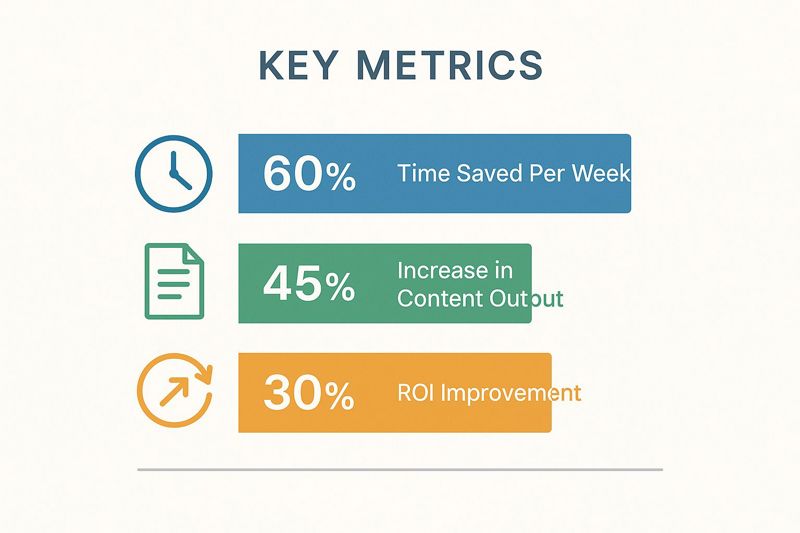The Evolution of Content Creation Automation

Remember the first time you scheduled a social media post? It felt like magic, a true time-saver. Today, content creation automation has moved far beyond simple scheduling, changing how brands connect with their audiences.
From Basic Scheduling to AI Ecosystems
Early content creation automation tools focused primarily on scheduling posts. This allowed marketers to plan content in advance and maintain a consistent online presence. But as marketing evolved, so did the need for more advanced tools. Consumers now expect personalized content delivered across various platforms.
This shift led to the development of more sophisticated solutions. Today's AI-powered ecosystems can generate, optimize, and distribute content with remarkable precision. This means businesses can create significantly more content, with fewer resources.
This growth is evident in the market itself. The digital content creation automation market is experiencing a boom. It's projected to grow from $27.99 billion in 2024 to $31.93 billion in 2025. By 2029, it's expected to reach $57.04 billion. Find more detailed statistics here
This expansion is driven by AI-powered tools enabling 3D content, cross-platform publishing, and personalized experiences. The increasing use of social media and the demand for scalable solutions also contribute to this growth. Now, almost every industry, from retail to healthcare, utilizes automated workflows to enhance content production.
The Rise of Intelligent Content Systems
The newest content creation automation tools use artificial intelligence (AI) in exciting new ways. AI-driven platforms analyze data, understand audience preferences, and generate original content in various formats, including text, images, and video.
For example, AI can write product descriptions, create social media captions, and even produce scripts for short videos. This allows human marketers to focus on strategy, creativity, and building stronger relationships with their target audience.
The Impact of Consumer Expectations
Consumer expectations are shaping the future of content creation automation. Modern audiences want authentic, personalized experiences. They expect brands to understand their individual needs and preferences. This presents both a challenge and an opportunity.
It's now harder than ever to stand out from the competition. However, brands using content creation automation can create highly targeted campaigns that truly resonate with their audience. This leads to deeper connections and improved results. The continuing evolution of content creation promises even more exciting advancements in the coming years.
AI-Powered Tools Revolutionizing Content Creation

The once-daunting blank page is now a playground for AI-powered content creation. This new wave of automation is changing how businesses develop, create, and optimize their content. Leading brands are incorporating these tools, seeing significant improvements in productivity and expanding their reach. The data chart above visualizes current AI adoption rates for various content creation tasks. Marketers are clearly embracing AI tools for streamlining their workflows.
Natural Language Processing: Crafting Human-Quality Content
One of the most significant impacts of AI is in natural language processing (NLP). NLP allows machines to understand and generate human-like text with remarkable accuracy. Think compelling product descriptions, engaging social media posts, and even blog post drafts. This frees up human writers to focus on strategy and relationship building with their audience.
Visual Storytelling with AI Image Generation
AI is transforming visual content creation, too. AI image generation tools like DALL-E 2 are becoming essential for marketers. These tools create unique images from text descriptions, allowing brands to quickly generate visuals for various needs. This eliminates the need for costly photoshoots and time-consuming design processes, making visual storytelling more accessible.
Video Automation: Multimedia at Scale
Video content is key for engagement. Creating high-quality videos, however, can be resource-intensive. Video automation tools are simplifying the process. AI can assist with video editing, transcription, and even generation, allowing for more video content with fewer resources. This makes multimedia marketing more scalable for all businesses.
The Growth of Content Creation Automation
The content creation automation market is booming, reflecting its growing importance. This sector is projected to grow from $2.9 billion in 2024 to $3.53 billion in 2025, a 21.9% compound annual growth rate (CAGR). By 2029, the market is expected to reach $7.74 billion. This growth is driven by advancements in AI algorithms, particularly in personalization and real-time optimization. Explore this topic further.
Currently, 77% of marketers are using AI for copywriting and visual asset generation. Platforms like Canva and Jasper are automating up to 50% of design and drafting tasks for many Fortune 500 companies. Integration with marketing automation systems allows AI to generate email campaigns, social posts, and targeted ads, while simultaneously analyzing performance data.
Current Adoption Rates and Trends
The following table compares several popular AI content creation tools:
Popular AI Content Creation Tools Comparison A comparison of leading AI content creation tools showing their key features, strengths, and ideal use cases
| Tool Name | Content Types | Key Features | Pricing Model | Best For |
|---|---|---|---|---|
| Jasper | Blog posts, social media copy, marketing emails, website content | Long-form content generation, SEO optimization, multiple templates | Subscription | Businesses needing diverse content formats |
| Copy.ai | Social media captions, product descriptions, ad copy, email subject lines | Short-form content generation, various writing styles, brainstorming tools | Subscription | Social media management and quick content creation |
| Rytr | Blog posts, articles, social media posts, emails, product descriptions | Multiple languages, plagiarism checker, tone adjustment | Subscription | Individuals and small businesses seeking affordable options |
| Anyword | Landing page copy, blog posts, ads, social media captions | Predictive performance scores, A/B testing features, audience targeting | Subscription | Data-driven marketers focused on conversion optimization |
| Canva | Social media graphics, presentations, posters, documents, videos | Design templates, image editing, collaboration tools | Freemium (paid subscription for advanced features) | Visual content creation for various platforms |
This table highlights the diverse range of AI content creation tools available. Each platform caters to specific needs and content types, from short-form social media captions to long-form blog posts. The pricing models also vary, offering options for individual users and large businesses. The best tool for you depends on your specific content requirements and budget.
Building Effective Content Automation Workflows

Creating truly effective content automation depends on a well-designed workflow. It's not enough to simply adopt the newest tools. You need to integrate them strategically into your existing processes. This section offers a practical framework for building automation systems tailored to your specific business needs. This involves careful planning, tool selection, and continuous optimization.
Auditing Your Current Content Production
The first step toward effective content creation automation is understanding your current process. Begin by conducting a thorough audit of your content production, from initial ideation to final distribution. Pinpoint bottlenecks, repetitive tasks, and areas where automation can provide the greatest benefit.
For example, are your writers spending excessive time on research or formatting? Are your designers recreating similar graphics repeatedly? These are prime candidates for automation. Identifying these pain points will help you streamline your workflow and maximize efficiency.
Identifying Automation Opportunities
After identifying areas for improvement, prioritize tasks based on potential ROI and ease of implementation. Some tasks, like scheduling social media posts, are relatively simple to automate. Others, like creating long-form content, require more complex workflows.
Start with the easier tasks to build momentum and demonstrate the value of automation to your team. This early success can encourage wider adoption and pave the way for more complex automation projects. AI-powered tools are increasingly being used to automate API documentation, a vital aspect of software development. This reflects the growing trend of automation in content creation. For a deeper dive into this topic, check out this resource: Auto Generate API Documentation.
Selecting the Right Technology Stack
Choosing the right technology is crucial for successful automation. Evaluate different platforms and tools based on your particular needs and budget. Consider factors such as content types, integration capabilities, and user-friendliness. There isn't a one-size-fits-all solution.
Some tools are excellent for generating short-form content, while others are better suited for creating visual assets or producing videos. Finding the right tools for your specific needs is essential for achieving your content automation goals. To learn more about creating an effective marketing automation strategy, read our article: How to master your marketing automation strategy.
Implementing Integration Points
Seamless integration between tools and systems is crucial for efficient workflows. Ensure your chosen tools can communicate effectively with each other and integrate with your existing systems, such as your CRM or email marketing platform.
This integration enables automated data flow and eliminates manual data entry, saving valuable time and reducing errors. Streamlining this data exchange ensures your content creation process runs smoothly.
Maintaining Quality and Brand Consistency
While automation offers substantial benefits, maintaining quality control remains paramount. Implement checkpoints within your automated workflows to review content before publication.
This ensures brand consistency and prevents errors that could potentially damage your reputation. These checkpoints act as a safety net, catching any inconsistencies or inaccuracies before they reach your audience.
Team Adoption and Training
Successful automation relies on team buy-in. Invest in training and provide continuous support to help your team adapt to the new workflows. Address any concerns about job security or the perceived limitations of AI.
Emphasize that automation frees up human creativity for more strategic and impactful tasks. By empowering your team, you can ensure a smoother transition to automated processes.
Real-World Examples and Challenges
Businesses across various industries are using content creation automation to boost efficiency and scale content production. However, implementation challenges are common. One challenge is finding the right balance between automation and human creativity.
Another key challenge is ensuring data privacy and security. Proactively addressing these challenges is essential for successful implementation and maximizing the benefits of automation.
By focusing on these key elements, you can build robust content creation automation workflows that significantly enhance your content marketing efforts. This leads to increased efficiency, improved quality, and ultimately, better business results.
Measuring ROI and Performance of Automated Content
Understanding the true return on investment (ROI) of your content automation efforts is crucial. This means looking beyond superficial metrics like social media likes and focusing on tangible business impact. This section explores how to effectively measure and optimize your content automation strategy.
Building a Comprehensive Performance Dashboard
Effective automation programs use dashboards that track a range of key performance indicators (KPIs). These dashboards offer a holistic view of content performance, encompassing productivity gains, cost savings, engagement, leads, and conversions. This comprehensive approach helps you grasp the full impact of your automation investment.
For instance, track time saved by automating content generation or social media posting. Also, monitor the reduction in content creation costs compared to traditional methods. These efficiency metrics showcase the practical value of automation. You might be interested in: How to master your automated marketing workflow.
Establishing Realistic Benchmarks and A/B Testing
Setting realistic benchmarks is essential for gauging the effectiveness of your automated content. These benchmarks should align with your marketing objectives and industry averages. A/B testing is also critical. Compare automated content performance against manually created content to identify areas for improvement. This data-driven approach ensures informed decision-making.
Automation isn't just about creating more content; it's about creating more effective content. Continuously testing and refining your approach maximizes the impact of your efforts. Marketing automation statistics reveal a significant ROI, with businesses earning $5.44 for every $1 invested in automated content workflows. Over 40% of brands have already fully automated customer journeys.
Interpreting Data and Communicating Success
Data interpretation is key to optimizing your content automation strategy. Analyze data from your performance dashboard and A/B tests to identify trends and areas for improvement. Are certain automated content types performing better? Which automation workflows yield higher ROI? Use these insights to refine your approach and maximize results.
Demonstrating automation's value to stakeholders requires more than raw data. Create compelling ROI stories that showcase the tangible benefits, highlighting cost savings, productivity gains, and increased conversions. This persuasive communication is essential for securing continued investment in content automation technologies.
Key Metrics for Content Automation ROI
The following table, "Content Automation ROI Metrics," outlines essential KPIs for measuring the success and return on investment of your content automation initiatives. It provides a framework for tracking and analyzing performance, enabling you to demonstrate the value of your automation investments and continually optimize your strategy.
| Metric Category | Key Metrics | Measurement Method | Target Benchmarks |
|---|---|---|---|
| Efficiency | Content production time, Cost per piece of content | Track time spent and resources used before and after automation | Reduction in production time and cost |
| Engagement | Website traffic, Social media engagement (likes, shares, comments), Email open and click-through rates | Analytics platforms (e.g., Google Analytics) | Increase in key engagement metrics |
| Conversions | Lead generation, Sales conversions, Customer lifetime value | CRM and marketing automation platforms | Improvement in conversion rates and customer lifetime value |
| Quality | Error rate, Brand consistency, Customer satisfaction | Content audits, Customer feedback surveys | Low error rate, Consistent brand messaging, High customer satisfaction |
By focusing on these key metrics, you can build a stronger case for continued investment in content creation automation and ensure its long-term success.
Balancing Automation and Human Creativity

The best content strategies blend the speed of automation with the ingenuity of human creativity. This means carefully choosing which tasks are best suited for automation and which ones require a human touch. This balance is the key to creating truly engaging content that stands apart from generic, mass-produced material.
Defining the Balance: What to Automate and What to Keep Human
Many top brands are seeing success with hybrid human-AI content teams. This approach combines the efficiency of content creation automation tools like Jasper with the strategic thinking and emotional intelligence of human writers. AI excels at tasks like generating data-driven reports or creating variations of existing content. Humans, on the other hand, can focus on crafting compelling narratives, developing innovative campaign ideas, and maintaining a consistent brand voice.
This division of labor allows both humans and AI to shine. It maximizes efficiency and ensures the final product resonates authentically with the intended audience. This is especially important for content meant to connect on an emotional level. For further insights, you can learn more in our article about personalized content.
Avoiding Content Homogenization and Maintaining Authentic Voice
One common concern about automation is the potential for content homogenization. If everyone uses the same tools and templates, content can start to sound generic and lose its unique personality. However, this can be avoided by using automation strategically.
Think of AI tools as assistants, not replacements for human writers. They can handle time-consuming tasks like research and initial drafting. However, humans should always be involved in the editing and refinement process. This ensures the final content reflects the brand’s distinct voice and resonates with the target audience.
Upskilling Your Team for the Age of AI
Successfully integrating content creation automation means upskilling your team. Provide training on how to use AI tools effectively and how to adapt workflows to incorporate these technologies. This empowers your team to leverage AI's power while preserving their creative edge.
Furthermore, encourage experimentation and creative problem-solving within automated workflows. This cultivates a culture of innovation and keeps your team ahead of the curve. It also allows you to discover new and interesting ways to combine human and AI capabilities.
Addressing Concerns About Creativity Limitations
Some creatives fear that AI will limit their creativity. However, many find that automation actually boosts their creative output. By freeing them from tedious tasks, AI tools allow creatives to focus on higher-level thinking, strategic planning, and generating truly original ideas.
This shift allows human creatives to concentrate on what they do best: imagining, innovating, and connecting with audiences emotionally. This blend of human creativity and AI efficiency produces more impactful and engaging content.
Building Successful Hybrid Human-AI Content Teams
Organizations successfully integrating AI into their content creation processes are building hybrid teams. These teams combine the strengths of both humans and AI. They recognize the limitations of each and use their respective strengths to create a powerful synergy.
By thoughtfully balancing automation and human creativity, these teams create content that is both efficient and engaging. This approach ensures content remains authentic and resonates with its target audience, maximizing impact and achieving business goals.
Future Trends in Content Creation Automation
The current state of content automation is undeniably impressive. However, it's merely a stepping stone to what's coming next. Emerging technologies promise to revolutionize how we create and share content, offering exciting opportunities for businesses willing to embrace the future.
Multimodal AI Systems: A Seamless Blend of Content
A major trend on the horizon is the rise of multimodal AI systems. These systems seamlessly weave together different content formats like text, images, audio, and video, creating a cohesive and engaging experience. Imagine AI crafting a blog post complete with relevant visuals, a corresponding podcast episode, and even a short promotional video—all from a single prompt. This opens up incredible possibilities for expanding the reach and impact of your content marketing.
Hyper-Personalization: Tailoring Content to Each Individual
Hyper-personalization is another key development. While current tools offer basic personalization, future AI will deliver truly individual experiences. This goes beyond simply addressing someone by name; it's about tailoring content to each user's specific interests, behaviors, and preferences. This deeper level of personalization can build stronger audience connections and significantly increase conversion rates.
New Distribution Mechanisms: Reaching Your Audience in Innovative Ways
Content distribution is also undergoing a transformation. Beyond established channels like email marketing platforms and social media, exciting new avenues are emerging. Think interactive virtual environments, augmented reality experiences, and personalized content feeds delivered directly to smart devices. These innovations will fundamentally alter how brands interact with their audiences.
Preparing for the Future of Content Automation
Staying ahead requires proactive planning. Here's how businesses can prepare for these future trends:
Investing in Strategic Technology: Carefully evaluate and adopt new content automation tools that align with your long-term goals. Don't chase every new gadget; focus on solutions that deliver genuine value.
Developing Essential Skills: Equip your team with the skills to effectively collaborate with increasingly advanced AI systems. This includes training in data analysis tools, content strategy, and AI tool management.
Embracing a Future-Proof Mindset: Cultivate a culture of continuous learning and adaptation. The content automation landscape is dynamic, so flexibility is crucial for long-term success.
Building a robust and future-proof content automation strategy is essential for any modern business. This proactive approach enables you to capitalize on emerging innovations while avoiding costly missteps. It positions you to be a leader in the next generation of content creation.
Ready to transform your image creation process and personalize your visual content at scale? Explore OKZest today and discover how easy it is to create unique, engaging images that resonate with your audience. Visit OKZest now.